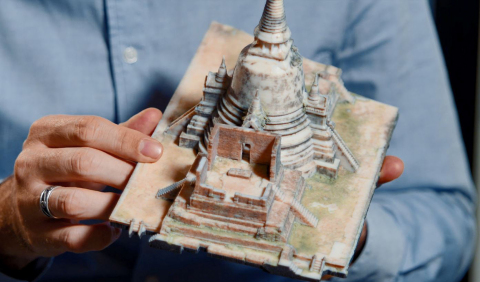Google Arts and Culture re-creates forgotten history with Stratasys J750 3D Printer - advancing new possibilities for learning, education, and art appreciation
MINNEAPOLIS & REHOVOT, Israel — (BUSINESS WIRE) — January 30, 2019 — Underscoring the power of realism in 3D printed models, Stratasys (Nasdaq: SSYS) and Google Arts and Culture are re-imagining some of the world’s most cherished artifacts and historical monuments through additive manufacturing. Backed by advanced color and multi-material functionality of the Stratasys J750 3D Printer, historians can now re-create these items digitally and physically – raising both awareness and accessibility of ancient history.
This press release features multimedia. View the full release here: https://www.businesswire.com/news/home/20190130005371/en/

A 3D printed model of Ayutthaya temple in Thailand, produced using the Stratasys J750 (Graphic: Business Wire)
Google Arts and Culture is capitalizing on Stratasys technology for its Open Heritage Project - designing and creating historical pieces with multi-material and multi-color 3D printed prototypes. With 3D printing, these remains can be more effectively preserved and shared– with files available for download around the world. The result is enhanced accessibility, in-depth understanding, and enriched appreciation of centuries-old cultures.
“The project was to explore physically making these artifacts in an effort to get people hooked and excited about seeing pieces in a museum or research context. That’s when we turned to 3D Printing,” said Bryan Allen, Design Technologist at Google. “With the new wave of 3D Printed materials now available, we’re able to deliver better colors, higher finish, and more robust mechanical properties – getting much closer to realistic prototypes and final products right off the machines.”
The Stratasys J750 3D Printer offers some of the broadest color ranges for creation of highly realistic models. Leveraging more than a half million distinguishable colors and materials – from rigid to opaque, flexible to transparent – design teams can better align output with design objectives - all while streamlining iterations and advancing functionality of 3D printed models.
One of the major initiatives for Google Arts and Culture is restoration of rare plaster casts initially discovered by A.P. Maudslay during the late 1800s in Guatemala. For more than 100 years, these relics were housed across storage facilities in the British Museum. By leveraging 3D laser scanners to virtually re-assemble each, designers successfully reconstructed these items in physical form with Stratasys 3D printing – later allowing representations to be easily viewed by a wider audience online.
“The J750 empowers designers to actually achieve their ultimate goal – matching the final 3D print to what is initially seen on the screen. Combining rich colors and translucency in a single print, designers and engineers can build models with heightened levels of accuracy and realism – mirroring opaque or transparent structures, and even complex materials like rubber,” said Rafie Grinvald, Enterprise Product Director of Rapid Prototyping, Stratasys. “Our relationship with Google Arts and Culture is the perfect demonstration of 3D printing paying off – with models that look and feel like the real thing.”
Key pieces of the Google Arts and Culture Open Heritage Project are available anytime online – exploring the backstory and 3D printed representation of each historical location. Visitors can access the models at https://artsandculture.google.com/project/cyark.
“When we talk to arts and culture preservationists, historians, and museum curators – they’re all absolutely amazed by the ability to fabricate these things with such high fidelity via 3D printing technology,” concluded Allen.
For a closer look into the work Google Arts and Culture is doing with Stratasys, please click here.
Stratasys is a global leader in additive manufacturing or 3D printing technology, and is the manufacturer of FDM® and PolyJet™ 3D Printers. The company’s technologies are used to create prototypes, manufacturing tools, and production parts for industries, including aerospace, automotive, healthcare, consumer products and education. For 30 years, Stratasys products have helped manufacturers reduce product-development time, cost, and time-to-market, as well as reduce or eliminate tooling costs and improve product quality. The Stratasys 3D printing ecosystem of solutions and expertise includes: 3D printers, materials, software, expert services, and on-demand parts production. Online at: www.stratasys.com, http://blog.stratasys.com and LinkedIn.
Stratasys is a registered trademark and the Stratasys J750 and Stratasys signet are trademarks of Stratasys Ltd. and/or its subsidiaries or affiliates. All other trademarks are the property of their respective owners.
Attention Editors, if you publish reader-contact information, please use:
- USA +800-801-6491
- Europe/Middle East/Africa +49-7229-7772-0
- Asia Pacific +852 3944-8888
View source version on businesswire.com: https://www.businesswire.com/news/home/20190130005371/en/
Contact:
Stratasys Corporate & North America
Email Contact
+1
612-364-3208
Japan and Korea
Email Contact
+81
3 5542 0042
Europe, Middle East, and Africa
Jonathan Wake / Miguel
Afonso, Incus Media
Email Contact
+44
1737 215200
Mexico, Central America, Caribe and South America
Email Contact
+55
11 2626-9229
Greater China, Southeast Asia, ANZ and India
Alice Chiu
Email Contact
Brazil
Email Contact
Email Contact
GP
Communications
+55 (11) 3129 5158